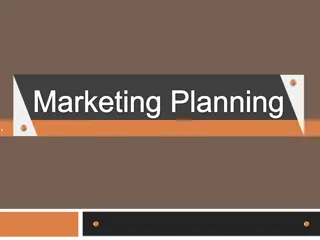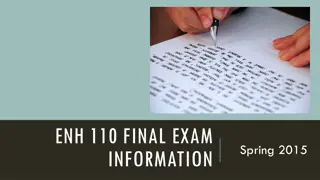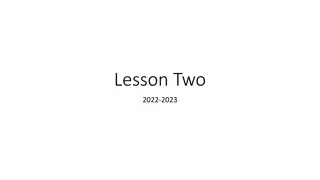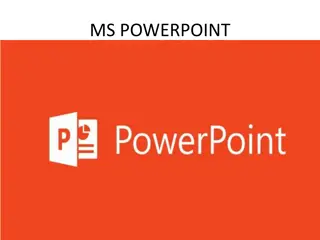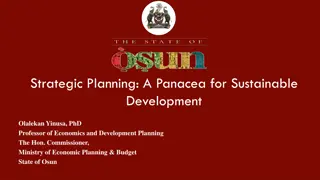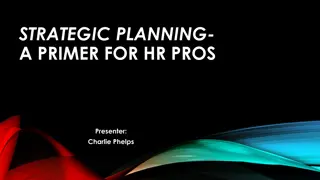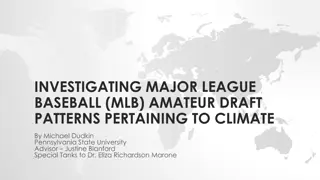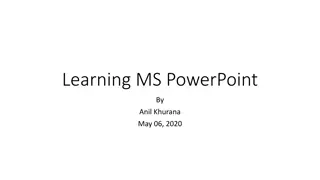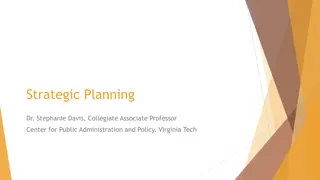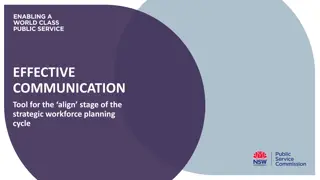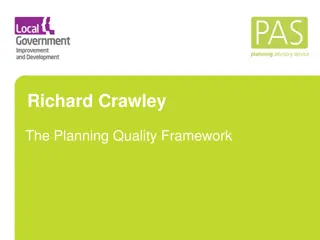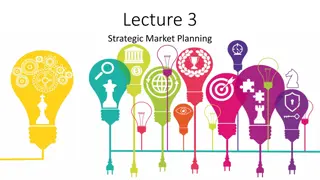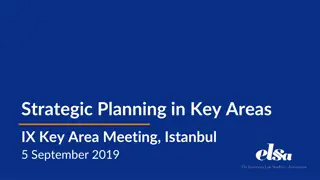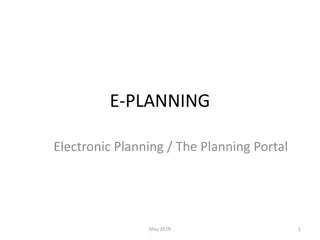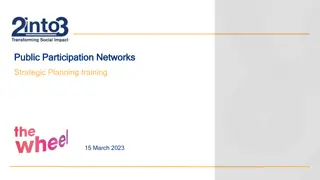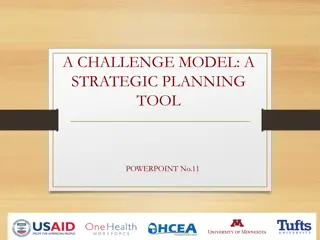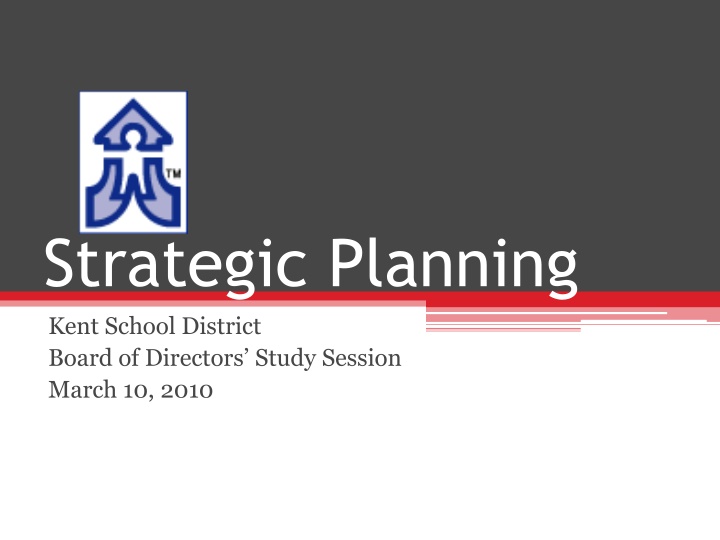
Developing a Strategic Plan for Kent School District
Explore the process and importance of strategic planning for the Kent School District, involving community stakeholders to create a roadmap for achieving long-term goals. Learn about the key steps in strategic planning, the characteristics of a good strategic plan, and the importance of aligning resources with organizational priorities.
Download Presentation

Please find below an Image/Link to download the presentation.
The content on the website is provided AS IS for your information and personal use only. It may not be sold, licensed, or shared on other websites without obtaining consent from the author. If you encounter any issues during the download, it is possible that the publisher has removed the file from their server.
You are allowed to download the files provided on this website for personal or commercial use, subject to the condition that they are used lawfully. All files are the property of their respective owners.
The content on the website is provided AS IS for your information and personal use only. It may not be sold, licensed, or shared on other websites without obtaining consent from the author.
E N D
Presentation Transcript
Strategic Planning Kent School District Board of Directors Study Session March 10, 2010
Board Goal Number 6: Develop a Strategic Plan In partnership with community stakeholders, Kent School District will develop a strategic plan to guide the district in achieving its vision for 2010 and beyond To begin the process, preliminary goals were adopted in September 2009, and preliminary action plans adopted in December, 2009
Preliminary Planning Steps To jump start the process before strategic planning Superintendent s Entry Plan Preliminary Board Goals Preliminary Action Plans for 2009-2010 (2011) Next step: Strategic Plan Development (Multi- year Plan)
What is Strategic Planning? Process to establish priorities on what you will accomplish over the next 5-10 years Provides focus to make choices on what to do Pulls the entire organization together around a single game plan for execution Broad outline on where resources will get allocated Note: reference Matt H. Evans on Strategic Planning
A Good Strategic Plan should . . . Address critical performance issues Create the right balance between what an organization is capable of doing vs. what the organization would like to do Visionary convey a desired future end state Flexible allow and accommodate change Guide decision making at all levels operational, tactical, individual
Common Strategic Planning Steps Working with community to define critical issues and develop objectives Identify the stakeholder groups who will participate Students, parents, teachers, support staff, administrators, higher education, community partners Identify the issues and objectives for improvement, for example, all students should read on grade level by grade 3 Strategy sessions to define and write the action steps toward achieving objectives Putting the steps into a calendar Projecting budget to support actions Realigning staff duties to implement plan Tracking progress monthly Reassessing plan twice a year
Major Components of the Strategic Plan / Down to Action Strategic Plan Action Plans Mission Why we exist Evaluate Progress Vision What we want to be Goals What we must achieve to be successful Specific outcomes expressed in measurable terms (NOT activities) Objectives O1 O2 Planned Actions to Achieve Objectives Initiatives AI3 AI2 AI1 Indicators and Monitors of success Measures M1 M2 M3 Targets T1 T1 T1 Desired level of performance and timelines
Why do Strategic Planning? Plan your work and work your plan. If you fail to plan, then you plan to fail be proactive about the future Strategic planning improves performance Promote vision and long-term thinking Look at the big picture to solve major issues Communicate to everyone what is most important
Fundamental Questions to Ask When Planning Begins Where are we now? (Assessment) Examples include looking at each school s achievement for NCLB, Getting to Graduation statistics Where do we need to be? (Gap/Desired Future) How will we close the gap? (Strategic Plan) How will we monitor our progress and adjust our plan?
Make the Plan to Plan Leadership commitment: everyone must support the plan Early Decisions: Who will do what? What will each group do? How will we do it? When is the best time?
Include the A-B-Cs Assessment Baseline Components Down to Specifics Evaluation
Assessment Assessment Model: S W O T resources, people, culture, systems, partnerships, . . . Internal Assessment: Organizational assets, External Assessment: Changing marketplace, social trends, technology, regulatory environment, economic cycles . SWOT SWOT Possible Pitfalls Good Points Needs to be Analytical and Specific Be honest about your weaknesses/needs Easy to Understand Apply at any organizational level
Assessment Strengths Strengths Those things that you do well, the high value or performance points Strengths can be intangible: Good leadership, strategic insights, solid reputation, high skilled staff Often considered Core Competencies Best leverage points for growth Build on your strengths
Assessment Weaknesses Weaknesses Those things that prevent you from doing what you really need to do Since weaknesses are internal, they are within your control Weaknesses include things such as: disorganization, lack of focus, undertrained workforce, insufficient resources, outdated technologies, lack of planning, difficulty in reaching consensus . . .
Assessment Opportunities Opportunities Potential areas for growth and higher performance External in nature competition for resources, positioning for upcoming changes in regulations Internal opportunities should be classified as strengths Timing may be important for capitalizing on opportunities
Assessment Threats Threats Challenges confronting the organization, external in nature Threats can take a wide range new regulations, rapidly changing economic picture, huge demographic shifts May be useful to classify or assign probabilities to threats The more accurate you are in identifying threats, the better position you are for dealing with the sudden ripples of change
Baseline Why create a baseline? Puts everything about the organization into a single context for comparability and planning Descriptive about the organization as well as the overall environment Baseline grounded in descriptive data Examples include Achievement Gaps identified between subgroups of students 3 National Merit Scholars
Baseline Baseline / Org Profile Gap Analysis Challenges / SWOT Gap = Basis for Long-Term Strategic Plan
Components Major Components of the Strategic Plan / Down to Action Strategic Plan Action Plans Mission Why we exist Evaluate Progress Vision What we want to be Goals What we must achieve to be successful Specific outcomes expressed in measurable terms (NOT activities) Objectives O1 O2 Planned Actions to Achieve Objectives Initiatives AI3 AI2 AI1 Indicators and Monitors of success Measures M1 M2 M3 Targets T1 T1 T1 Desired level of performance and timelines
Components Mission Statement Captures the essence of why an organization exists Who they are, what they do Explains the basic needs that it fulfills If possible, conveys the unique nature of an organization and the role it plays that differentiates it from others
Components Examples Good and Bad Mission Statements NASA To Explore the Universe and Search for Life and to Inspire the Next Generation of Explorers Does a good job of expressing the core values of the organization. Also conveys unique qualities about the organization. Walt Disney Too vague and unclear. Need more descriptive information about what makes the organization special. To Make People Happy
Mission Statement Successfully Prepare All Students for Their Future
Components Vision How the organization wants to be perceived in the future what success looks like An expression of the desired end state Challenges everyone to reach for something significant inspires a compelling future Provides a long-term focus for the entire organization Example: All Kent students will graduate qualified with skills and knowledge to succeed in the post- secondary option of their choice
Components Guiding Principles and Values Every organization should be guided by a set of values and beliefs Provides an underlying framework for making decisions part of the organization s culture Values are often rooted in ethical themes, such as honesty, trust, integrity, respect, fairness, . . . . Values should be applicable across the entire organization
Components Examples of Guiding Principles and Values We expect to be measured by what we do, as well as what we say. We believe in equity and excellence for all of our students. We expect staff and students to develop their skills to their highest potential. We are committed to forging public and private partnerships that combine diverse strengths, skills and resources.
Components Goals Describes a future outcome that is supportive of the mission and vision. Shapes the way ahead in actionable terms. Best applied where there are clear choices about the future. Puts strategic focus into the organization May need to adapt when things are changing fast
Components Developing Goals Cascade from the top of the Strategic Plan Mission, Vision, Guiding Principles. Look at your strategic analysis SWOT, Environmental Scan, Past Performance, Gaps Limit to a critical few such as five to eight goals. Broad participation in the development of goals: Consensus and buy-in at all levels Should drive higher levels of performance and close critical performance gaps.
Components Examples of Goals prepared Examples of Goals * Increase student achievement. * Provide Quality and Innovative Learning Environments. Manage our resources with fiscal responsibility and efficiency through a single comprehensive process that is aligned to our strategic plan. Partner with businesses, industry leaders, colleges and universities, and government agencies in order to better meet the needs of stakeholders across the entire system. Provide timely and accurate support information to help close the achievement gap.
Components Objectives Relevant - directly supports the goal Compels the organization into action Specific enough so we can quantify and measure the results Simple and easy to understand Realistic and attainable Convey responsibility and ownership Owned by those who must execute May need several objectives to meet a goal
Components Examples of Objectives Examples of Objectives academic levels in preparation for success in college, career, and civic life. Each and every Kent School District student will meet high standards and achieve at high Kent School District will establish a comprehensive culture of accountability that ensures the successful implementation of the District s vision. All third grade students will read at grade level by June annually. Maintain our technology refresh program to provide up to date equipment every three years. Monitor and address school climate issues through an annual survey across all site stakeholder groups.
Down to Specifics What are Action Plans? The Action Plan identifies the specific steps that will be taken to achieve the initiatives and strategic objectives where the rubber meets the road Each Initiative has a supporting Action Plan(s) attached to it Action Plans are geared toward operations, procedures, and processes They describe who does what, when it will be completed, and how the organization knows when steps are completed Like Initiatives, Action Plans require the monitoring of progress on Objectives, for which measures are needed Objectives Initiatives Action Plans
Down to Specifics Characteristics of Action Plans Assign responsibility for the successful completion of the Action Plan. Who is responsible? What are the roles and responsibilities? Detail all required steps to achieve the Initiative that the Action Plan is supporting. Where will the actions be taken? Establish a time frame for the completion each steps. When will we need to take these actions? Establish the resources required to complete the steps. How much will it take to execute these actions? Who, What, When, Where, How Much
Down to Specifics Action Plans have Measurable Targets For each measurement, there should be at least one target Targets should stretch the organization to higher levels of performance Incremental improvements over current performance can be used to establish targets
Down to Specifics Examples of Targets Achievement Gap for all AYP Groups close Percent of all students reading on the proficient level increases Student graduation rate increases annually Personnel Fully Trained in SIOP proportionate to need 20% by Year 2011 10% by Year 2011 30% by Year 2012 20% by Year 2012 50% by Year 2013 30% by Year 2013 80% for Year 2010 40% by Year 2011 90% for Year 2011 45% by Year 2012 95% for Year 2012 50% by Year 2013
Down to Specifics Sanity Check . . . Make sure everything is linked and connected for a tight end-to-end model for driving strategic execution. OBJECTIVE Improve Graduation Rate MEASURE / TARGET 90% Measure Percent Satisfaction Current Graduation Rate 75% ga p INITIATIVE ACTION PLAN Getting to Graduation Base actions on study recommendations Target 90% Target Actual
Evaluate Performance Management Establish a regular review cycle. Analyze and compare trends using graphs for rapid communication of performance. Don t be afraid to change your time lines. Planning is very dynamic must be flexible to change. Recognize and reward good performance results. Brainstorm and change take corrective action on poor performance results.
Evaluate Link Budgets to Strategic Plan The world s best Strategic Plan will fail if it is not adequately resourced through the budgeting process Strategic Plans cannot succeed without people, time, money, and other key resources Aligning resources validates that initiatives and action plans comprising the strategic plan support the strategic objectives
Evaluate What Resources? How to Link? Every Action Plan should identify the following: The people resources needed to succeed The time resources needed to succeed The money resources needed to succeed The physical resources (facilities, technology, etc.) needed to succeed
Some Final Thoughts Integrate all components from the top to the bottom: Vision > Mission > Goals > Objectives > Measures > Targets > Initiatives > Action Plans > Budgets. Get Early Wins to create some momentum Seek external expertise when needed
Role of the Board Preliminary Goals Adopted 9/23/2009 Preliminary Action Plans Adopted 12/03/2009 Next: Selection of Plan Facilitator to assist with long term planning for a broader and deeper plan Create a steering committee Create subcommittees as goals are confirmed
Strategic Plan Facilitators Cambridge Strategics WASA WSQA (Baldridge Process) WSSDA Let s take a look at some specifics on each Interviews/presentations could be arranged
Consultant Group Cost/Time Commitment Year one high $50,000s District planning Description of Process Cambridge Strategics is a large national planning company. Plans they have facilitated have a professional format. There is software available to assist with plan publication. WASA provides a flexible process matched to the needs. Step 1, design, works to help decide on participants and how to engage the public. Step 2, facilitate meetings, public forums, and focus groups. In Step 3, help design the Action Plan. Five Meetings one month apart covering overview of the process, work with Community Planning Team , review of mission or vision and belief statements, development of action plans, timelines, budgets, and assignments through development of evaluation model. WSQA is a nonprofit organization dedicated to helping organizations achieve superior results through the use of the Baldridge Criteria. Consultant Rene Ewing assists organizations with mission, vision, and values, and strategic initiatives and goals through a flexible and responsive planning style. Advantages National experience with a track record of success. 36 district list. Washington specific experience; Plan process tailored to district needs. Questions High Cost; Extended plan cycle. Washington specific experience? Facilitator not identified. Several facilitators possible based on availability. Cambridge Design only: $5,000; Facilitate Meetings: $5,000; 3 month commitment WASA $6000 cost estimate; 5 month commitment School Board support organization. Meeting schedule is well defined over 5 months. Facilitator not identified. Several facilitators possible based on availability. WSSDA $165/hr. , $6,000 estimate; 3 month process Seattle and Wenatchee Plans strong. Facilitator very successful at other Washington districts. Who designs the final product? Participating districts' plans are very different. WSQA (Baldridge Criteria)
Cambridge Strategics Large national planning organization Three-Five year plan built by proven methods Training in planning can be provided to Board and Leadership prior to beginning process Three year costs may equal $100,000 List of supported districts attached: 36 sample districts listed Books/training manuals and software published on successful planning process available
WASA (Washington Association of School Administrators) WASA has several consultants who have assisted Washington school districts with their plans: Dr. Al Cohen, Olympia Dr. Wayne Robertson, Edmonds, Conway, Lakewood Mr. John Dekker, coordinator Districts also served include Kelso, White Pass, Darrington Cost is estimated at $12,000 Process is customized and takes approximately 3 months
WSQA (Baldridge Process) This group represents the Washington State Quality Award and assists school districts to The Performance Path to Excellence through the Baldridge Criteria: Leadership Strategic Planning Customer Focus Data Analysis Human Resource Focus Process Improvement Results



